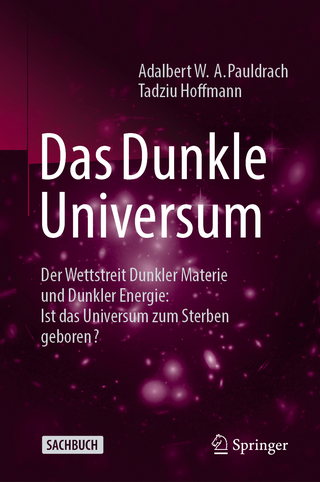
The Physical Processes and Observing Techniques of Radio Astronomy
Springer International Publishing (Verlag)
978-3-319-16981-1 (ISBN)
This is a textbook for undergraduate courses on radio astronomy. Written by an active professor and researcher in the field, it begins by explaining why conducting observations at radio frequencies is so important, then reviews essential physics concepts corresponding to a sophomore-level curriculum or higher. Next, the book introduces students to single dish telescopes and interferometers. The most commonly encountered emission mechanisms seen in radio astronomy are then explained, along with examples of astronomical sources broadly divided into the types of sources seen in galactic and extragalactic observations.
Each chapter provides examples and exercises suitable for homework assignments. Also included is an appendix of useful supplementary material. Altogether, the book is a comprehensive, yet digestible starting point for physics and astronomy undergraduates looking to understand the basics of radio astronomy.
Dr. Thomas Pannuti earned his PhD in physics in 2000 from the University of New Mexico in Albuquerque, New Mexico. His dissertation research concentrated on multi-wavelength observations (namely X-ray, optical and radio) of supernova remnants in nearby galaxies. He worked as a postdoctoral associate at the MIT Center for Space Research (now known as the Kavli Institute for Space Science and Astrophysics) in Cambridge, Massachusetts from 2000 – 2003 and then as a postdoctoral scholar at the Spitzer Science Center in Pasadena, California from 2003 – 2006. In 2006 he joined the Department of Earth and Space Sciences at Morehead State University in Morehead, Kentucky as an assistant professor of space science. He was promoted to an associate professor of space science and astrophysics in 2012. His current research interests include multi-wavelength observations of Galactic and extragalactic supernova remnants and radio continuum observations of blazars. He has served as first author or co-author on nearly 40 publications in the refereed literature. In recognition of his research efforts, in 2012 he received the Superlative Award Winner for Distinguished College or University Scientist from the Kentucky Academy of Science. He is an active teacher, researcher and advisor in astronomy at the Space Science Center – a research center in space science and astrophysics – in the Department of Earth and Space Sciences at Morehead State University.
Introduction: Why Make Observations at Radio Frequencies?- Angles, Gravity, Light, The Bohr Model of the Atom and Relativity.- Emission Mechanisms: Blackbody Radiation, An Introduction to Radiative Transfer, Synchrotron Radiation, Thermal Bremsstrahlung and Molecular Transitions.- Radio Observations: An Introduction to Fourier Transforms, Observing Through Earth's Atmosphere, Single Dish Telescopes and Interferometers.- Solar System Radio Astronomy: The Sun, The Planets, The Moon and Minor Bodies.- Galactic Radio Astronomy: Galactic Structure, HII Regions, Supernova Remnants, Neutron Stars and Pulsars.- Extragalactic Radio Astronomy: Galaxy Classification, Active Galactic Nuclei, Superluminal Motion, Galaxy Clusters and the Microwave Background.- Solutions.- Index.
"Radio astronomy is increasingly accessible as part of the undergraduate teaching curriculum, both as a practical activity and as part of the broader study of astrophysics. ... it is well illustrated with colour figures, has a good set of sample problems with answers ... . For those looking for a short one-volume text, it is certainly worth considering." (Martin Hardcastle, The Observatory, Vol. 141 (1284), October, 2021)
“Radio astronomy is increasingly accessible as part of the undergraduate teaching curriculum, both as a practical activity and as part of the broader study of astrophysics. … it is well illustrated with colour figures, has a good set of sample problems with answers … . For those looking for a short one-volume text, it is certainly worth considering.” (Martin Hardcastle, The Observatory, Vol. 141 (1284), October, 2021)
| Erscheint lt. Verlag | 14.11.2020 |
|---|---|
| Reihe/Serie | Undergraduate Lecture Notes in Physics |
| Zusatzinfo | XVIII, 393 p. 96 illus., 54 illus. in color. |
| Verlagsort | Cham |
| Sprache | englisch |
| Maße | 155 x 235 mm |
| Themenwelt | Naturwissenschaften ► Physik / Astronomie ► Astronomie / Astrophysik |
| Technik ► Elektrotechnik / Energietechnik | |
| Schlagworte | Emission Mechanisms Explained • Extragalactic Radio Astronomy • Radioastronomie • Radio Astronomy Basics • Radio Emission • Single Dish Telescopes • Synchrotron radiation • Thermal Bremsstrahlung Radiation |
| ISBN-10 | 3-319-16981-5 / 3319169815 |
| ISBN-13 | 978-3-319-16981-1 / 9783319169811 |
| Zustand | Neuware |
| Haben Sie eine Frage zum Produkt? |
aus dem Bereich


